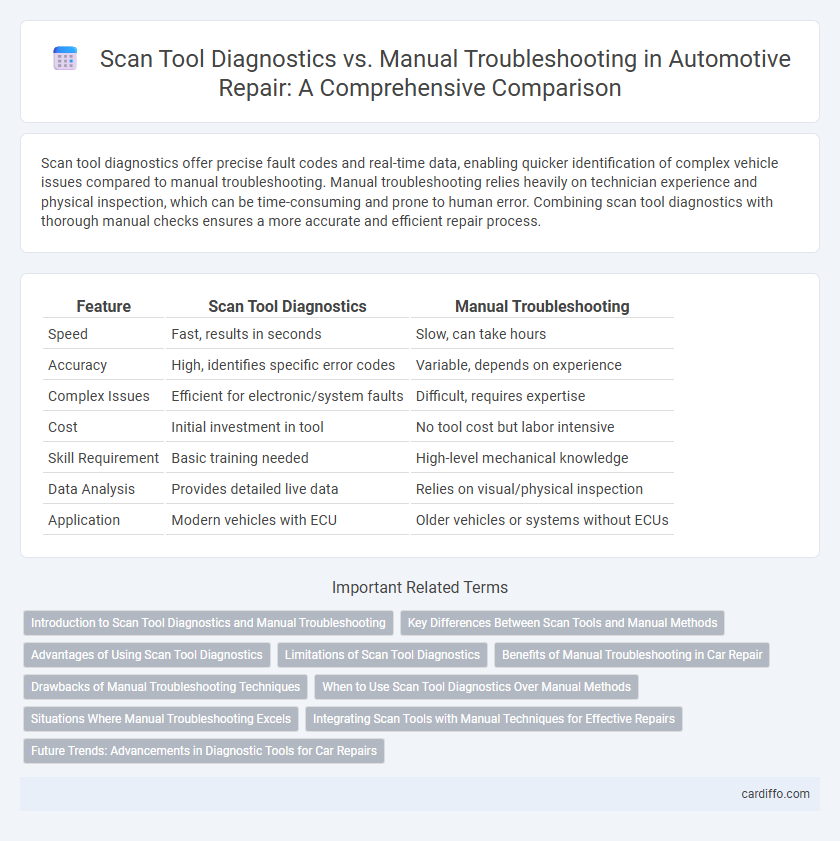Scan tool diagnostics offer precise fault codes and real-time data, enabling quicker identification of complex vehicle issues compared to manual troubleshooting. Manual troubleshooting relies heavily on technician experience and physical inspection, which can be time-consuming and prone to human error. Combining scan tool diagnostics with thorough manual checks ensures a more accurate and efficient repair process.
Table of Comparison
| Feature | Scan Tool Diagnostics | Manual Troubleshooting |
|---|---|---|
| Speed | Fast, results in seconds | Slow, can take hours |
| Accuracy | High, identifies specific error codes | Variable, depends on experience |
| Complex Issues | Efficient for electronic/system faults | Difficult, requires expertise |
| Cost | Initial investment in tool | No tool cost but labor intensive |
| Skill Requirement | Basic training needed | High-level mechanical knowledge |
| Data Analysis | Provides detailed live data | Relies on visual/physical inspection |
| Application | Modern vehicles with ECU | Older vehicles or systems without ECUs |
Introduction to Scan Tool Diagnostics and Manual Troubleshooting
Scan tool diagnostics use electronic devices to quickly read error codes and real-time data from a vehicle's onboard computer systems, enabling precise identification of faults. Manual troubleshooting relies on hands-on inspection, component testing, and intuition based on experience to locate and resolve problems without electronic assistance. Combining scan tool diagnostics with manual troubleshooting optimizes repair accuracy and efficiency by leveraging advanced technology alongside skilled technician expertise.
Key Differences Between Scan Tools and Manual Methods
Scan tool diagnostics offer precise fault code identification and real-time data monitoring, enabling faster and more accurate problem detection compared to manual troubleshooting. Manual methods rely heavily on technician experience and visual inspections, which can be time-consuming and prone to human error. Scan tools enhance efficiency by quickly accessing a vehicle's onboard computer systems, whereas manual troubleshooting involves sequential testing and interpretation of symptoms.
Advantages of Using Scan Tool Diagnostics
Scan tool diagnostics offer precise fault detection by quickly identifying error codes from a vehicle's onboard computer system, enabling faster and more accurate repairs compared to manual troubleshooting. These tools provide real-time data and comprehensive system analysis, reducing guesswork and minimizing downtime. Utilizing scan tools enhances diagnostic efficiency and accuracy, leading to better repair outcomes and optimized vehicle performance.
Limitations of Scan Tool Diagnostics
Scan tool diagnostics often rely on predefined error codes and sensor data, limiting their ability to identify complex or intermittent issues that do not trigger alerts. They may miss subtle mechanical problems or faults outside the scope of onboard sensors, requiring manual troubleshooting for comprehensive diagnosis. The effectiveness of scan tools is constrained by software updates and vehicle compatibility, reducing their reliability in certain repair scenarios.
Benefits of Manual Troubleshooting in Car Repair
Manual troubleshooting in car repair allows technicians to apply hands-on expertise, enabling precise identification of underlying mechanical issues beyond what scan tool diagnostics can reveal. This method facilitates real-time assessment of vehicle components, considering factors like unusual noises, vibrations, or physical wear that may not trigger diagnostic codes. Skilled manual inspection often leads to more effective repairs, reducing unnecessary part replacements and improving overall vehicle reliability.
Drawbacks of Manual Troubleshooting Techniques
Manual troubleshooting techniques often lead to prolonged diagnostic time due to reliance on technician experience and trial-and-error methods, increasing downtime and repair costs. These techniques are prone to human error, causing misdiagnosis and ineffective repairs that compromise vehicle performance and safety. Scan tool diagnostics provide precise fault codes and real-time data, minimizing guesswork and improving accuracy compared to manual methods.
When to Use Scan Tool Diagnostics Over Manual Methods
Scan tool diagnostics offer precise fault code identification and live data monitoring, making them ideal for complex electronic systems and when time efficiency is critical. Use scan tools for modern vehicles equipped with advanced computer modules, as they provide accurate diagnostic information beyond manual visual inspections. Manual troubleshooting suits simple mechanical issues but falls short in diagnosing intricate sensor and communication faults detected efficiently by scan tools.
Situations Where Manual Troubleshooting Excels
Manual troubleshooting excels in complex electrical issues where scan tools may not detect intermittent faults or wiring problems. It allows technicians to apply hands-on expertise and intuitive problem-solving to interpret subtle symptoms beyond diagnostic trouble codes. Situations involving sensor calibration or mechanical linkage faults often require manual inspection to accurately identify and resolve the root cause.
Integrating Scan Tools with Manual Techniques for Effective Repairs
Integrating scan tool diagnostics with manual troubleshooting enhances repair accuracy by combining real-time data analysis with hands-on inspection to identify complex vehicle issues. Scan tools provide precise error codes and system statuses, while manual techniques verify mechanical conditions and uncover problems beyond sensor capabilities. This hybrid approach reduces repair times, minimizes diagnostic errors, and improves overall vehicle reliability.
Future Trends: Advancements in Diagnostic Tools for Car Repairs
Emerging advancements in scan tool diagnostics leverage artificial intelligence and machine learning to deliver precise, real-time analysis of complex vehicle systems, significantly enhancing fault detection accuracy compared to manual troubleshooting. Integration of cloud-based databases enables continuous updates, allowing scan tools to diagnose the latest vehicle models and software versions with improved efficiency. These innovations are transforming car repairs by reducing diagnostic time, minimizing human error, and supporting predictive maintenance for proactive vehicle health management.
Scan tool diagnostics vs Manual troubleshooting Infographic

 cardiffo.com
cardiffo.com